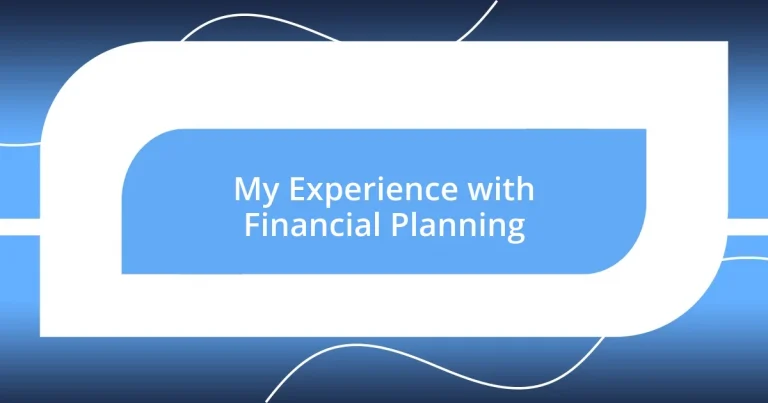Key takeaways:
- Setting specific financial goals and tracking income and expenses significantly transformed the author’s financial journey from anxiety to empowerment.
- Adjusting financial plans in response to life changes, such as career shifts or becoming a parent, is crucial for maintaining control and financial resilience.
- Measuring success through clear benchmarks, like achieving savings milestones and monitoring net worth, fosters confidence and emotional stability in financial planning.

Understanding Financial Planning Basics
Understanding financial planning basics can feel overwhelming at first, but I remember my own journey starting with the simplest elements. Initially, I focused on setting specific financial goals—like saving for emergencies or planning a vacation. This clarity transformed my approach from anxiety over finances to excitement about achieving my dreams.
As I delved deeper into budgeting, I found it crucial to track my income and expenses. Honestly, the first time I laid everything out in a spreadsheet, it was like uncovering a hidden reality. I realized how much I was spending on little luxuries that didn’t bring me joy. Have you ever had that moment? It’s eye-opening and a bit liberating to see where your money is actually going.
Insurance and investments often seemed like distant concepts to me, but they’re essential parts of financial planning. I recall the turning point when I learned that insurance isn’t just a safety net; it provides peace of mind. By investing, I discovered the potential of growing my wealth over time. Isn’t it fascinating how these tools can shape our financial futures? They really are the engines driving us toward our goals.

My Personal Financial Goals
My personal financial goals have evolved significantly over the years. Initially, I aimed to build an emergency fund to cover three to six months of expenses. That sense of security gave me a newfound confidence—the kind that makes facing unexpected bills feel like merely a bump in the road instead of a mountain to climb.
As I became more comfortable with saving, I started to think about future dreams, like buying a home. I recall sitting in my favorite coffee shop, sketching out a rough budget. The excitement of mapping my path to homeownership transformed an abstract goal into a tangible plan. It felt empowering to know that I was in control of my financial destiny, rather than letting life’s uncertainties dictate it.
Now, I’m keenly focused on creating a diverse investment portfolio. I often ask myself, “How can I make my money work harder for me?” By exploring stocks, bonds, and mutual funds, I’ve recognized the importance of long-term growth. It’s thrilling to think about how each small decision can contribute to my financial future.
| Financial Goal | Description |
|---|---|
| Emergency Fund | Saving to cover 3-6 months of living expenses |
| Home Purchase | Funding a down payment for my first home |
| Investment Portfolio | Diversifying investments for long-term growth |

Creating a Budget that Works
Creating a budget that works is one of the most empowering steps I’ve taken in my financial planning journey. I remember the first time I sat down with a blank piece of paper, and it struck me how overwhelming my thoughts about budgeting were. But then, I broke it down into simple steps. What helped me immensely was using categories like essentials, savings, and discretionary spending. By giving each dollar a purpose, I regained control over my finances.
Here are some key strategies I found effective:
- List Down Income Sources: Identify all streams of income, from salary to side hustles.
- Track Every Expense: I found it vital to track everything, even those small daily purchases. It adds up!
- Allocate Funds Wisely: I set specific limits for categories based on my priorities and long-term goals.
- Review and Adjust Regularly: Life happens, so I regularly revisit my budget to adjust for changes in income or unexpected expenses.
- Find Accountability Partners: Sharing my goals with a friend kept me motivated and on track.
Enjoying budgeting has been an unexpected journey for me. It’s not just numbers; it’s about my values and aspirations. The moment I realized that every expense is a choice, I shifted my perspective. I started saying no to things that didn’t align with my goals, and that felt incredibly freeing.

Investment Strategies for Beginners
When I first dipped my toes into investing, the sheer number of options felt daunting. One strategy that resonated with me was dollar-cost averaging, which involves investing a fixed amount regularly, regardless of market conditions. This approach eased my anxiety because it allowed me to build my investment over time while potentially reducing the impact of market volatility. I often think, “Is there a better way to navigate the ups and downs of the market?” For me, this method felt like a safety net.
Exploring index funds became a game-changer in my investment strategy. They offer diversification and lower fees compared to actively managed funds, allowing me to participate in a broader market without needing to pick individual stocks. I remember the moment I realized I could own a tiny piece of countless companies just by investing in an index fund. It felt empowering, almost like having a seat at a large, exclusive table, and this made the prospect of investing less intimidating.
Finally, I learned that setting specific investment goals helps sharpen my focus. Whether it was saving for a vacation or retirement, each goal had a different timeline and risk tolerance associated with it. I once set a modest target for a short-term travel fund, and as I watched that investment grow, it transformed my understanding of patience and planning. I often ask myself, “How can I align my investments with my personal ambitions?” Finding those connections made every decision more meaningful, almost like watching a storyline unfold in my financial journey.

Tools for Effective Financial Tracking
Effective financial tracking has been a revelation in my personal journey, and today, I can’t imagine managing my finances without certain tools. For me, budgeting apps like Mint transformed the way I visualize my spending. They not only categorize expenses but also provide real-time insights, allowing me to adjust my habits on the fly. I’ve often thought, “How can I keep my spending in check while still enjoying life?” These apps have shown me that it’s possible to strike a balance.
Spreadsheets are another fantastic option that I find extremely effective. I remember the weekend I dedicated to creating a comprehensive spreadsheet that captured my income, expenses, and savings goals. It was an enjoyable process that involved a bit of creativity and provided clarity. Imagine seeing all your financial information in one place! It’s mesmerizing how visualizing your data can spark motivation to hit your financial targets. Plus, I love customizing it to fit my needs—it’s like my own financial dashboard.
Lastly, I’ve also turned to financial journals, which might seem old-fashioned but have an undeniable charm. Writing down my financial thoughts and experiences has helped me reflect on my decisions. I often ask myself, “What did I learn from this month’s spending?” These journals combine my personal journey with financial tracking in a way that feels therapeutic. I find that documenting my progress not only reinforces my goals but also keeps me accountable. There’s something incredibly rewarding about putting pen to paper and watching my financial narrative unfold over time.

Adjusting Plans for Life Changes
Adjusting my financial plans in response to life changes has been one of the most necessary and enlightening aspects of my financial journey. I vividly recall the month I learned I would become a parent. Suddenly, my priorities shifted, and I realized my previous budget was inadequate for the new responsibilities. I had to re-evaluate my savings goals, reassess my investment strategies, and build a solid emergency fund while still preparing for this exciting new chapter. It was like constructing a financial safety net just when I needed one most.
A few years later, when I switched careers, the need for adjustment arose once again. I had to account for a temporary paycheck gap while transitioning between jobs. It forced me to tighten my budget and eliminate discretionary spending. I remember sitting down with my partner and discussing our financial priorities, which opened up an honest dialogue about our expenses and future aspirations. Asking ourselves, “What can we sacrifice now for greater security later?” made the adjustments feel purposeful rather than burdensome.
Life is unpredictable, isn’t it? I’ve learned that being proactive is crucial. Whenever there’s a significant life event—be it marriage, a new job, or even moving to a new city—revisiting and adjusting my financial plans reinforces my sense of control. It’s empowering to realize that with each life change, I can reshape my financial future. I often ponder, “How can each adjustment bring me closer to my goals?” This mindset not only encourages adaptability but also strengthens my overall financial resilience.

Measuring Success in Financial Planning
Measuring success in financial planning is often subjective, but I’ve found it incredibly illuminating to establish clear benchmarks. For instance, reaching a specific savings milestone, like having six months’ worth of expenses set aside, made me feel a profound sense of security. I remember that moment vividly; the relief washed over me like a cool breeze on a hot day. It’s the small victories, like paying off a credit card or achieving my investment growth targets, that keep me motivated to stay the course.
Another metric I focus on is my net worth, which serves as a tangible measure of my overall financial health. I can still recall the first time I calculated it—it felt like taking a snapshot of my financial life. I was astounded to see it grow over time through disciplined saving and investing. I often wonder, “How can a simple number encompass my financial journey?” Tracking my net worth reminds me that every decision I make impacts my financial future, making this process feel very personal and goal-oriented.
Lastly, I believe that success also lies in financial calmness and confidence. The day I realized I could navigate unexpected expenses without stress was a game changer. I had built enough of a buffer to handle surprises, like a car repair or an emergency medical bill, without panic. Doesn’t it feel liberating to know that you can weather financial storms? This shift in my mindset defines success in my financial planning journey—it’s not just about numbers; it’s about emotional stability and peace of mind.














